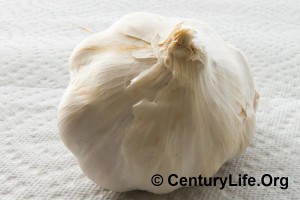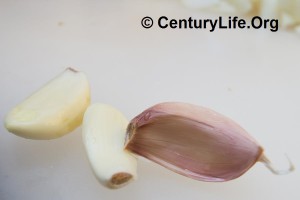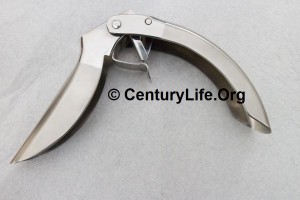HISTORY:

Garlic (Allium sativum) is a species in the onion genus, and thus genetically similar to onions, leeks, shallots, and chives. Garlic originated in central Asia, and humans have grown garlic for at least 7,000 years throughout Eurasia and Africa for use as a panacea for gastrointestinal and other health problems. Garlic has long been treasured for its ability to flavor foods, but what makes garlic especially potent is how it stimulates production of antioxidants.
How it works:
Free radicals are molecules with an odd number of electrons, which are often formed from exposure to oxygen. These free radicals rampage through cells and can even damage DNA.
Antioxidants are molecules that safely neutralize free radicals. Common antioxidants are vitamin E, vitamin C, and beta carotene (a precursor to vitamin A).

Your body naturally produces a small amount of hydrogen sulfide, and garlic stimulates your body to produce more.1
Furthermore, cut or crushed garlic releases the enzyme alliinase, which creates allicin, an antimicrobial and antifungal chemical. Allicin further breaks down the garlic and produces alliin, ajoene, diallyl polysulfides, vinyldithiins, S-allylcysteine (organosulfur compounds) which may act as an anti-inflammatory and inhibit cholesterol sythesis and platelet aggregation.2 Heat deactivates alliinase, so if you plan to cook garlic, try to cut/crush it and leave it alone for 10-15 minutes at room temperature before adding it to a meal. (To avoid unnecessary waiting, prepare garlic before any other ingredient.) You can also eat garlic raw.
The bottom line is that garlic may help your cardiovascular system and is a known anti-cancer food. In countries where there are regional populations with high garlic consumption, those groups have lower rates of colon and gastric cancer–however, garlic powder/pills and garlic oil apparently don’t give the same benefit as fresh, chopped/crushed garlic, and low consumption of garlic wasn’t particularly helpful.3 So if you’re going to try to use garlic as a cancer-fighting weapon, either eat it raw or let it sit for 10-15 minutes chopped/crushed, before adding it to your food; and in any case, eat lots of it–at least five cloves per day. You can do spread things out by adding a clove or two to every meal.
High garlic consumption can make one’s sweat and breath smelly (the organosulfurs are metabolized by your body into smelly allyl methyl sulfide), but you can suppress the smell a little bit by eating fennel seeds or drinking milk while you eat garlicky foods.4
GARLIC PRESSES
A word about garlic presses: They aren’t strictly necessary, since you can chop garlic on a cutting board. But if you have limited space on the board and not many prep bowls, or if you want to quickly smash entire garlic cloves–skin and all–to quickly start that 10-15 minute countdown, then you may want to get a garlic press.
The best garlic press I’ve ever used is the WMF Profi Plus Garlic Press.
The WMF has a swingaway design that allows you to run sink water through the basket. I usually use a knife to scrape as much garlic as possible off the basket and into a prep bowl. The peel stays in the basket, so you should dispose of the peel after every clove or two so that they don’t clog the press. The WMF is dishwasher-compatible.
If you want a cheaper stainless steel garlic press, get this generic garlic press; it’s made in China, feels flimsy (the handles are hollow), has straight handles that are not as comfortable or effective as the WMF, and is somewhat less effective–it doesn’t cut as easily and tends to lose more garlic (more garlic pulp squirts out as waste because the gaps between the metal basket and sides are larger than the gaps with the WMF garlic press). But if you plan to use a garlic press often, get the WMF because it will save you money and irritation in the long run, by wasting less garlic.

Lastly, don’t get the Kuhn Rikon Epicurean. Before my wife Ann and I met, she bought the Kuhn Rikon Epicurean Garlic Press. The Kuhn Rikon Epicurean handle curves the wrong way, making it less comfortable to use–especially if the garlic press is slippery from water/oil. That’s because less of your palm touches the handle. In contrast, the WMF Profi Plus has the main part of the handle angled away from the body of the press, allowing you to grip it with more of your hand and to exert more force without discomfort. And the WMF Profi Plus costs less than the Kuhn Rikon Epicurean, too.
CONCLUSION
Garlic adds flavor and is good for you, too. Remember to let chopped/crushed garlic sit for at least 10 minutes in order to allow enzymatic reactions time to produce more anti-carcinogenic molecules. High heat stops those reactions. You don’t need to buy a garlic press; it’s just for convenience/speed so you can speedily crush a bunch of garlic without taking up space on your cutting board or spending much time chopping or peeling. But if you do want a garlic press, then get the WMF.


